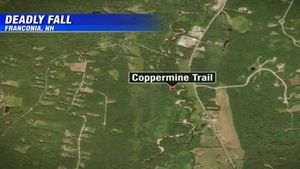Researchers have uncovered new insights about prehistoric hunting techniques used by early humans to bring down mammoths, shedding light on how these formidable creatures were eventually hunted to near extinction. Instead of using throwing spears as previously believed, recent studies suggest they braced stone-tipped spears, known as Clovis points, against the ground to create deadly pikes.
The study, led by archaeologists at the University of California, Berkeley, indicates how these sharpened rock tools were aimed upward to impale charging animals. This method would enable hunters to leverage the energy of the charging beast, driving the spear point deep and causing fatal wounds.
Clovis points, named after their first discovery site in Clovis, New Mexico, date back around 13,000 years and have been found extensively across North America. These tools were crafted from various stone types, including chert, flint, and jasper, and exhibited distinct features, like fluted indentations and razor-sharp edges.
Throughout history, there has been much debate among scholars about the precise use of these tools, with hypotheses ranging from throwing or stabbing to scavenging the wounded. The latest research, published in the journal PLOS ONE, challenges these earlier assumptions by presenting evidence of advanced hunting strategies involving planted pikes.
According to Scott Byram, one of the study's authors, "This ancient Native American design was an amazing innovation in hunting strategies." Byram emphasized how these techniques not only contributed to the survival of early human communities but also showcased their ingenuity and skill.
To validate their theory, the Berkeley team conducted experimental studies involving replica spear systems. They simulated animal attacks using these spear designs to efficiently measure how they would perform when clashing with large animals.
Their findings demonstrated the mechanics of how the spear system worked: upon piercing the animal's flesh, the Clovis point acted like modern hollow-point bullets, inflicting significant damage upon impact. Jun Sunseri, another co-author, explained, “The kind of energy generated by the human arm pales compared to the force of a charging animal, making this planted technique vastly more effective.”
Historically, researchers had often overlooked the notion of using planted weapons among prehistoric cultures, as no substantial evidence of such practices involving Clovis wooden spear shafts had surfaced. Yet, historical texts and artwork portray similar methods being utilized across various cultures for hunting and even military defense.
To gather additional insights, the research team plans to simulate attacks on replica mammoths, potentially using scaled models or pendulums to visualize and study the dynamics involved. This experiment promises to unravel more about how these ancient hunters interacted with megafauna.
Clovis technology not only serves as one of the earliest markers of human ingenuity but also as evidence of the complex relationship early humans had with their environment. The research highlights how they adapted to challenges, showcasing their dexterity beyond mere brute strength.
Looking at the broader scope, these findings contribute to unraveling the narrative of how prehistoric peoples managed their resources and sought food. Each discovery guides modern anthropologists toward appreciating the nuance of hunting efficiency and the engineering of effective tools.
All these elements collectively open new discussions on the sophistication present within Clovis culture. Further testing can provide richer understandings of how ancient peoples coexisted amid the towering shadows of now-extinct giants.
This study also raises questions about what remains undiscovered about other prehistoric hunting practices worldwide. By examining the evidence starkly and creating experimental reconstructions, researchers hope to peel back layers of history embedded within these ancient techniques.
The findings not only reflect the extraordinary intelligence and adaptability of early human societies but also stress the importance of collaboration among various academic disciplines. It highlights how integrating technology, archaeology, and anthropology can lead to groundbreaking revelations.
Through upcoming experiments, this research will certainly refine our perspectives on the ancient Clovis people and their adaptive strategies, cementing their place as skilled hunters who navigated the intricacies of their ecosystem.”



